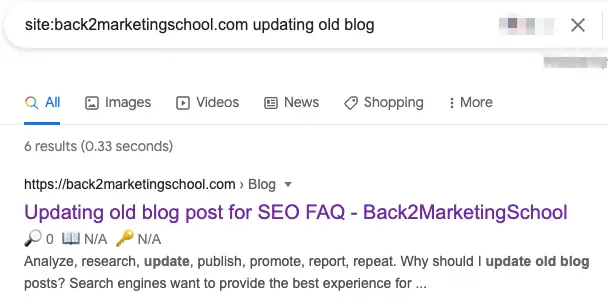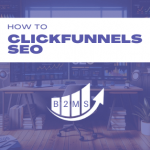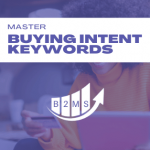7 Tips to increase SEO results with internal cross linking
I’m an SEO consultant for many businesses and I see those mistakes and missed opportunities every day. Cross linking your website with internal links is one of the most powerful, but yet one of the most underused SEO tactics.
What is internal cross linking in SEO?
Interlinking, internal links, or cross linking refers to the process of linking pages on your website with each other. The cross links have meaningful anchor texts to encourage user clicks and show search engines the keyword relevancy of the cross link.
How does Google read cross links?
Search engines read the source code of the page and therefore read links in HTML format:
<a href=”https://back2marketingschool.com/seo-answer-targeting/” target=”_blank” rel=”noopener”><span style=”font-weight: 400;”>answer SEO questions</span></a>
Every internal link looks somewhat similar to the above. Let’s analyze the different HTML link parameters:
href= | Link to another page (internal or external) |
“target=”_blank” | Opens the link in a new browser window/tab |
rel=”noopener” | Safety parameter when opening the link in a new window/tab |
>answer SEO questions< | Anchor text |
The anchor text is very important. Google and Co. associate the anchor text/keyword with the link – regardless if it’s an external or internal cross link.
Why are internal cross links so important for SEO?
Internal cross links are crucial for search engine optimization because they signal the importance of the page and increase the keyword relevancy to crawlers.
The logic is that important pages within your domain are being linked to from other resources within your website. The internal linking structure is one of the most powerful and underestimated SEO strategies.
Three further benefits of cross linking in SEO
- Keyword implementation: implementing keywords is somewhat limited on the page itself. You can implement SEO title tags, URLs, headlines, image alt attributes, and strong tags on the page. Incoming links with relevant, keyword-rich anchor texts are an additional opportunity.
- Link juice: When linking from a page that has a backlink pointing to it, you can inherit this backlink authority – at least partially – when cross linking to another page. This link affiliation is called link juice.
- User engagement: You make it easy for users to find relevant, related information and keep them engaged on your website. This also indirectly boosts SEO results due to lower bounce rates, which are now a ranking factor since the latest Google algorithm update.
7 SEO Tips for internal cross linking

1. Avoid On-Site SEO Errors of internal cross links
SEO has always two parts: the content aka keywords, but also the technical on-page SEO.
Avoiding the following On-Site SEO mistakes will not only increase the site health but also increase your organic rankings due to higher keyword relevancy at the same time.
- Don’t leave the anchor text blank – meaning have the URL itself as the anchor text. For instance, don’t use https:back2marketingschool.com, but rather Back2MarketingSchool.
- Don’t use non-relevant anchor texts such as “more”, “here”, or “link”. This gives you also the opportunity to implement short- or long-tail keyword links.
- Don’t link to a 301 redirect: always link to the final destination and avoid redirect chains.
Never link from an SSL secured HTTPS page to an unsecured HTTP page.
2. SEO Anchor Texts and Keywords
Anchor texts should be keyword-relevant. Keep in mind that the keyword is benefiting the cross linked page and not the page where the link is implemented. However, links should always be contextually relevant within the text. Remember how Google understands HTML links.
3. Add the safety parameter rel=”noopener”
You always want links to open in a new browser window or tab to keep the user on the current page. When interlinking, add the safety parameter rel=”noopener” to the HTML link code.
WordPress and Elementor do this for you. Anyways, make sure this is the case for your settings.
4. Plan your interlinking in your content brief already
When creating content for a blog post or page it’s always recommended to plan your internal cross links in advance. Especially, when tasking another writer, an SEO content brief can be helpful. I also suggest defining the anchor texts already, so the writer can use the keyword in a natural way.
A content calendar and keyword research table help with planning SEO linking.
In the review process, further cross link opportunities may occur.
In my experience, most website owners implement links in new content, even though leaving some opportunities unused. However, the biggest mistake I see is the following.
5. Interlink to the new post from existing pages
If you are very familiar with the content of your site or have a well-organized content calendar, you may identify cross link opportunities for the newly created page immediately. However, an even better trick is to conduct a site: search.
Conduct a Google search with “site:yourdomain.com keyword”
This search will only provide pages on the domain where the keyword appears.

Don’t just use your main keyword but also related long-tail keywords for further inbound links. Sometimes it also makes sense to update the old blog post further to also avoid keyword cannibalization if the topic has been discussed already.
6. Increase the time on page and user experience
A quick SEO Google Analytics analysis can help you to identify the top content-heavy pages that could benefit from additional cross links to keep readers engaged on your website.

In the Behavior View, I selected Content Drilldown to the blog page level. If you don’t use categories on your website this task is a little more manual.
Forget about the number of page views for this exercise and focus on engagement metrics like average time on page, bounce rate, and exit rate.
In the above screenshot, you can see the highlighted pages have a high average time on page, but also a relatively high bounce and exit rate. That indicates that people are liking the content by consuming it but then leave without visiting another page. Throughout the content and especially at the end, it would be advised to implement relevant cross links to keep the user engaged with content similar to what they are reading.
7. Leverage Link Juice of Backlinks
You can identify the pages with the most backlinks on your website in your SEO tools like SEMRush but also Google Search Console.
Google Search Console -> Links (in the left main navigation) -> External Links -> More

It’s common that the page with the most backlinks is your homepage. However, let’s focus on the content-heavy pages where it’s generally easier to implement additional cross links.
On the pages that have backlinks (incoming links), it’s recommended to interlink other pages to leverage the so-called link juice. The internal linked-to page will inherit some authority from the backlink to the original page.

Sascha is a Lifecycle Marketing Consultant with over 8 years of digital marketing experiences in Silicon Valley, the UK, and Germany.
After leading the demand generation for a 100+ million company, he decided to venture out on himself. He’s now helping clients to attract and convert more leads and customers.
His main focus are SEO, paid media & marketing automation – all with the focus to tie marketing campaigns to revenue.
Sascha has been featured in industry publications.



